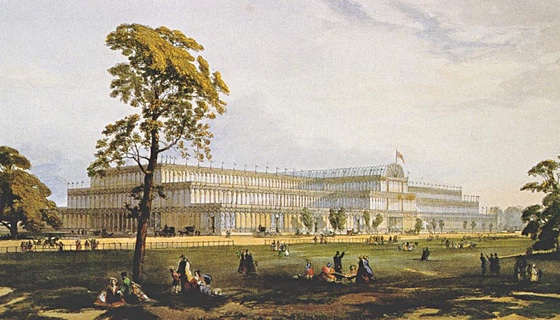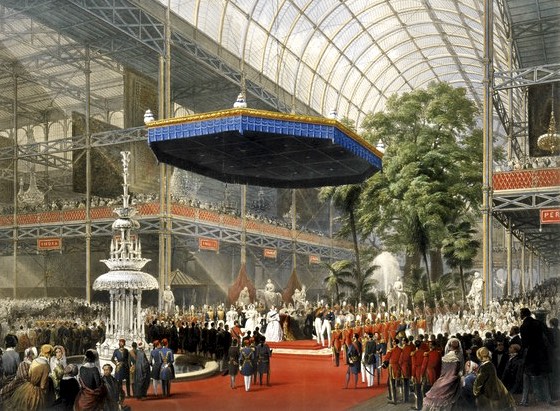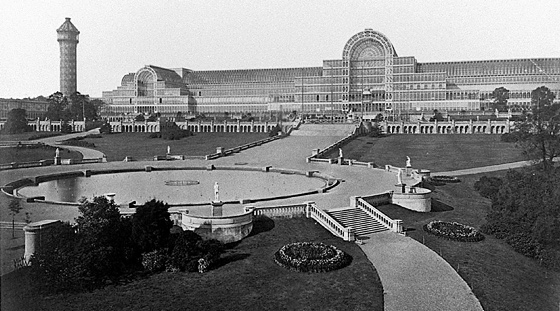
The Crystal Palace, a triumphant showcase of systematicity, built 1851
The rise and fall of “because”
Western culture, society, and selves all fell apart half a century ago. Or so say many theorists; and I agree. To understand how we relate to meaning now, and how we could better relate in the future, we need to understand that recent past.
A systematic culture answers “why” questions with “becauses.” The answers are reasonably consistent and coherent. A series of “why” questions eventually reaches an ultimate, eternal Truth. This Truth is the foundation of the system, which supposedly answers all questions for everyone, everywhere, eternally.
Religious systems, government systems, economic systems, aesthetic systems, philosophical systems, scientific systems, family systems: until a few decades ago, these provided iron frameworks for meaning. Meanings were held safely in place, certified by reliable structures.
This was an extraordinary accomplishment. Systems are not normal or natural. Almost no one has had them in the hundreds of thousands of years humans have been around. Nearly everyone has had to make do without becauses. Human progress over the past few centuries can be attributed almost entirely to systems.
Then, “because” stopped working. We are back in a becauseless world—like and unlike that of our pre-systematic ancestors.
We have not yet figured out how to live well without becauses. Suggestions about how to do that are the goal of Meaningness and Time. First, though, I will explain how “because” worked, how it stopped working, and where that leaves us.
Disclaimers
The history of the rise and fall of “because” is extremely interesting. However, it’s a standard academic topic that I have nothing new to say about. (My tale begins in the aftermath.) So this page presents just a brief summary, for readers who are unfamiliar with the backstory.
The question of how systems arose, and how (and whether) they failed, is one of the most extensively debated by historians. A careful account, with caveats and footnotes, would be much longer. My version may be a “Just So Story,” or fanciful fable. I find it illuminates recent events, but you have every right to be skeptical.
Historians often use the word “modern” to mean what I’m calling “systematic.” The “modern era” covers roughly the late 1400s until the late 1900s. However, “modern” has other meanings.1 To avoid confusion, I’ve chosen a non-standard word.
Why systematicity happens
A society builds a systematic culture when it becomes aware of alternatives. When your tribe meets another that thinks it’s not OK to marry cousins, like you do, the natural thing to do is to kill and eat those barbarians. In rare cases, this is impractical, and you are stuck with talking to them. They criticize your marriage system, which you didn’t even know you had, and theirs is horrifying. (Or dangerously appealing, if you don’t like the cousin you have to marry.) So now you need to come up with a justification, and stories about talking snakes with magic apples no longer cut it.
The European Renaissance is a key example.2 Global trade gradually made Western Europeans increasingly aware of alternative cultures: Eastern Orthodox Christianity, the Islamic world, and even China. A major push came with a wave of refugees from the Fall of Constantinople (1453), who brought with them the texts of Ancient Greece and Rome (which had been lost in the West), plus the culture of the Byzantine Empire, plus Persian and Arabic scholarship.

Interior of the Crystal Palace with Neoclassical decorations, 1851
Europeans gradually recognized many of these foreign ideas as serious challenges, or even as right. Meaningness became a problem. How to resolve conflicts between meanings?
The Renaissance got a head start by discovering that the Ancient Greek philosophers had asked the same question, and had found plausible answers. The rest is well-known: the Protestant Reformation (which ended choiceless Christianity), the European Enlightenment, the Scientific Revolution, the Industrial Revolution, the rise of capitalism, democracy, individual rights, and the general triumphal march of modernity.
Systematic society

Queen Victoria inaugurates the Crystal Palace, 1851
A systematic society has a multitude of social roles—unlike a choiceless society, which has only a few.3 Each role is defined by a code of regulations, which are rationally derived from Ultimate Truth. Roles fit together into complex institutions—church, state, corporation, community—that accomplish society’s proper goals. Everything makes sense—everything has a “because”—so everyone knows what they are supposed to do. These systems together provide a stable, harmonious social order. Relationships among people, and between people and God, work as they should. (Or, at any rate, this is the theory.)
Systematicity makes possible the division of labor. This crucial social technology enabled the spectacular economic, artistic, technological, and intellectual advances of the systematic era. Despite all the attractions of the choiceless mode, no one actually wants to return to it if that means giving up the benefits of the systematic one.4
Systematic culture

The Crystal Palace in 1854
Systematic culture provides the web of “becauses” that hold society and selves together. It explains why the way we do things is the right way.
Systematic culture is rational, in the original sense. “Ratio” is Latin for “reason,” both in the sense of “reasoning”—the thinking process—and “reasons”—meaning justifications. Systematic culture thinks out reasons for everything. Supposedly, these are based on unshakable foundations that can’t be argued against. The culture builds up, from there, a cathedral of consistent and coherent meanings and values, a vaulting architecture of columns and buttresses, beams and arches, principles and proofs; light and airy, yet firm enough to last till Judgement Day.
A systematic culture is reflective. It discusses itself, describes itself, judges itself, rationalizes itself. Systematic knowledge is abstract, explicit, codified, and universal. Whatever is good and true is good and true for all people everywhere, eternally. Systematic culture is learned in schools and from books more than by apprenticeship.
At the height of systematic culture, in the mid–1800s, religion, philosophy, politics, science, and all the arts were in agreement. Philosophy was not separate from theology, and atheism disqualified you as a philosophy professor. Religion was considered rational; it gave justifications consistent with common sense. Political and economic theory mainly justified the existing social order, drawing reasons from both religion and science. Science discovered the Will of God, as manifest in His Creation. Great art was, by definition, morally improving. Art expressed the highest values of the culture; it was pure, inspiring, and uplifting.
Or so went the official story. With hindsight, this may all sound ridiculous, and even repellent. We know that it failed conclusively a hundred years later. And there were, of course, prescient dissenters. But the internal contradictions in the systematic worldview were mainly invisible at the time, and it did work astonishingly well for several centuries.
The Crystal Palace, built in 1851, was a triumphant showcase of systematicity. An engineering and economic marvel, its elegant geometrical design also reflected the classical rationality of the time. At once it reflected the elegant symmetry and simplicity of Greek temples—great expressions of a previous systematic culture—and pointed to a glorious, literally En-lightened and up-lifted future.
The Palace was an enormous building with walls and roofs entirely of glass. Nothing like it had ever been seen. It was made possible by the invention of glass plate casting, just two years earlier, which was much cheaper and produced much higher-quality glass than earlier processes. The glass plates were assembled into modules, held in place with cast-iron beams. Standardization of the modules enabled mass production, a new systematic social technology. From design on paper to opening, it took only eight months to build the Palace, and its cost was a quarter that of a conventional building of the same size.
The Crystal Palace was built to hold The Great Exhibition. That was first World’s Fair: shows of culture and industry, art and commerce, that were major events for the next century. The Great Exhibition included displays of fine art from around the world and through the centuries; a concert hall; exhibits of all manner of manufactured goods such as cameras, jewelry, locks, guns, and musical instruments; cutting-edge technologies like telegraphs and microscopes; and entire working factories, such as a cotton mill that went from the raw material to finished cloth. It was a huge success.
Systematic self

John Calvin: a main contributor to the development of the systematic self
Living in a systematic society requires, and enables, a systematic self—quite different from a choiceless self.5
In the choiceless mode, you are defined by your relationships; mainly family ones. Being a daughter, mother, and cousin determines what you feel and do. The function of your self is balancing your personal impulses with the needs of others, according to those roles. Morality—being a good person—means maintaining harmony by conforming to collective clan decisions. The choiceless self belongs, and is embedded in a web of mutual caring.
This sort of self is incompatible with complex social institutions. Efficient, specialized work gives you obligations to strangers, on the basis of explicit rules, not felt needs. A self devoted to balancing needs based on relationships cannot make sense of systematic society. It can only experience impersonal obligations as unjust demands imposed by the powerful, for the gratification of their own desires, at the expense of everyone else. Such a self must violate these demands frequently, or (if subjugated) will feel constantly resentful.
To create a systematic self, you emerge from embeddedness, as an individual.6 An individual has relationships, where a choiceless self is relationships. For an individual, the obligations of a relationship are determined by impersonal, rational considerations, not by intensity of feelings.
Creating a systematic self involves hardening boundaries, so other people’s emotions don’t flood you and compel your actions. The subject/object boundary encloses a new inner world of private, reflective experience. Relationships themselves are brought inside, as objects you can consider rationally.
Where the choiceless self is a self, the systematic self has a self: it takes itself as an object in its inner world. The systematic self is able to reason about itself, in relation to others, according to roles, and can adjudicate their requirements dispassionately. For the systematic self, ethics—being a good person—means conforming to abstract systems of laws, rules, and institutions. It means conscientiousness: doing what you have explicitly agreed to do, regardless of how you and others feel about that. It means doing what is necessary to maintain the system and uphold its values.
At first this feels unnatural, but since you now have a self, you can act on your self. You become the administrator of your internal world. You can choose among competing desires systematically, instead of according to which yells louder. You can manipulate yourself into better behavior; into conformity with a systematic society. When successful, you reward yourself with self-esteem, which is abstract and purely internal, rather than with impulse-gratification.
All this is far more sophisticated than the choiceless self, whose inner world is just a chaos of emotions, which aren’t even particularly yours, most of the time.
A systematic self has an individual identity, which is not dependent on social roles. “Individual” literally means “not divided.” As chief of your inner world, you run the show. You have freedom of choice, rather than being torn between conflicting impulses and relationships. You experience yourself a single being, the same person in every circumstance, throughout your life.
A systematic self enables authorship, a mode of cultural creativity impossible in the choiceless world. You create as an individual, by manipulating objects in your private internal world, rather than by cooperatively manipulating external objects in the public world. The enormous flowering of culture that started in the Renaissance, and continued through the modern era, depends on such authorship.
Some historians trace the development of the systematic self to the Protestant Reformation, particularly to Calvinism.7 The Calvinist Reformers deliberately created a well-ordered society by disciplining the poor and demanding that even the aristocracy conform to strict religious morality. To make this possible, they developed new technologies of the self.
The Reformers extended to everyone spiritual practices that had been the preserve only of monks. They insisted that everyone examine the contents of their souls, and that everyone should discipline themselves based on what they found there. No longer could you be saved by passively attending church on Sunday. Every layman had to be his own confessor. Individual identity developed from this individual responsibility for salvation. The new, highly-regulated social order and the new, highly-regulated self were mutually supportive.
Eternalism simulates choicelessness
Systematicity is unnatural—and feels unnatural. Humans evolved in choiceless societies for hundreds of thousands of years. Systematicity began only a few thousand years ago, and it’s mostly only been significant for the past few hundred. Our brains are not adapted for it.8
Eternalism tries to provide some of the comforts of the choiceless mode, within the systematic mode. Eternalism substitutes certainty for choicelessness. If we could be truly certain, we would not have the burden of choice. If everything about culture and social roles were definitely right, we could go back to taking it for granted, without having to reflect on it.
The choiceless mode feels timeless, because you have no awareness of historical change. Eternalism substitutes universality for timelessness; it insists that what is true, is true eternally. But can you believe that?
Unfortunately, certainty is a poor substitute for choicelessness. Certainty implies at least the possibility of doubt. It demands belief. In the choiceless mode, doubt is impossible, because belief is unnecessary. You simply do the things your role calls for.
Also, of course, nebulosity is always obvious, so belief is impossible. The eternalist ploys—pretending, hope, faith, naiveté, and so on—never work for long.
The attraction of most contemporary spiritual systems—from fundamentalist Christianity to SBNR monism—is the implicit promise to return you to the choiceless mode. They lie, though. All they can offer is eternalism, not choicelessness.
- 1.For instance, in ordinary usage, “modern” often just means “current.” In art criticism, it covers the late 1800s to about 1980—only a small part of the period called “modern” by most historians. That narrower usage of “modern” corresponds to the period of “systems in crisis and breakdown” described next.
- 2.Systematicity is a matter of degree, not all-or-nothing. The earliest urban societies were already somewhat systematic five thousand years ago. Ancient India, China, Greece, and Rome were quite systematic at their peaks. Rome, especially, was astonishingly modern; it wasn’t until the 1600s, or perhaps even 1700s, that Europe caught up to where it had been a millennium and a half earlier. Rome’s modernity, and its success, was due to its cosmopolitanism: its willingness to adopt and adapt the life-ways of other cultures.
- 3.On the other hand, in a systematic society, each person has only a handful of roles; whereas in post-systematic societies, we all have so many we can’t keep track of them.
- 4.When I travelled in Asia, everywhere I went, I asked people “would you rather live here or in Singapore?” Everyone said “I love it here—I would miss the food, my family, the pace of life—but yeah, I’d rather live in Singapore where I could own a big TV.”
- 5.My explanation here draws on Robert Kegan’s model of psychological development. My “choiceless self” corresponds to his “interpersonal self”, and my “systematic self” to his “institutional self”. These are stages 3 and 4 of his 5-stage schema. “Fluidity” is meant to correspond to his stage 5.
- 6.According to Kegan, Americans in the 1970s typically created an “institutional self” when they left home for college, full-time work, or the military. Primary membership in an institution outside the family is a natural impetus. I’ve put “created” in the past tense, because—as I will explain in upcoming pages—I suspect it is no longer possible to create a systematic self in the way it was then.
- 7.For instance Charles Taylor, in A Secular Age. Other systematic societies developed similar self-technologies, presumably for the same reasons.
- 8.An interesting question is to what extent systematicity and brains have co-evolved recently. The cultural evolution of systematicity may exert strong, novel selective pressures, which may affect genetic evolution of brains. Conversely, as innate brain capacities have changed under this pressure, increasingly sophisticated and effective forms of systematicity may become feasible, driving social and cultural evolution.
